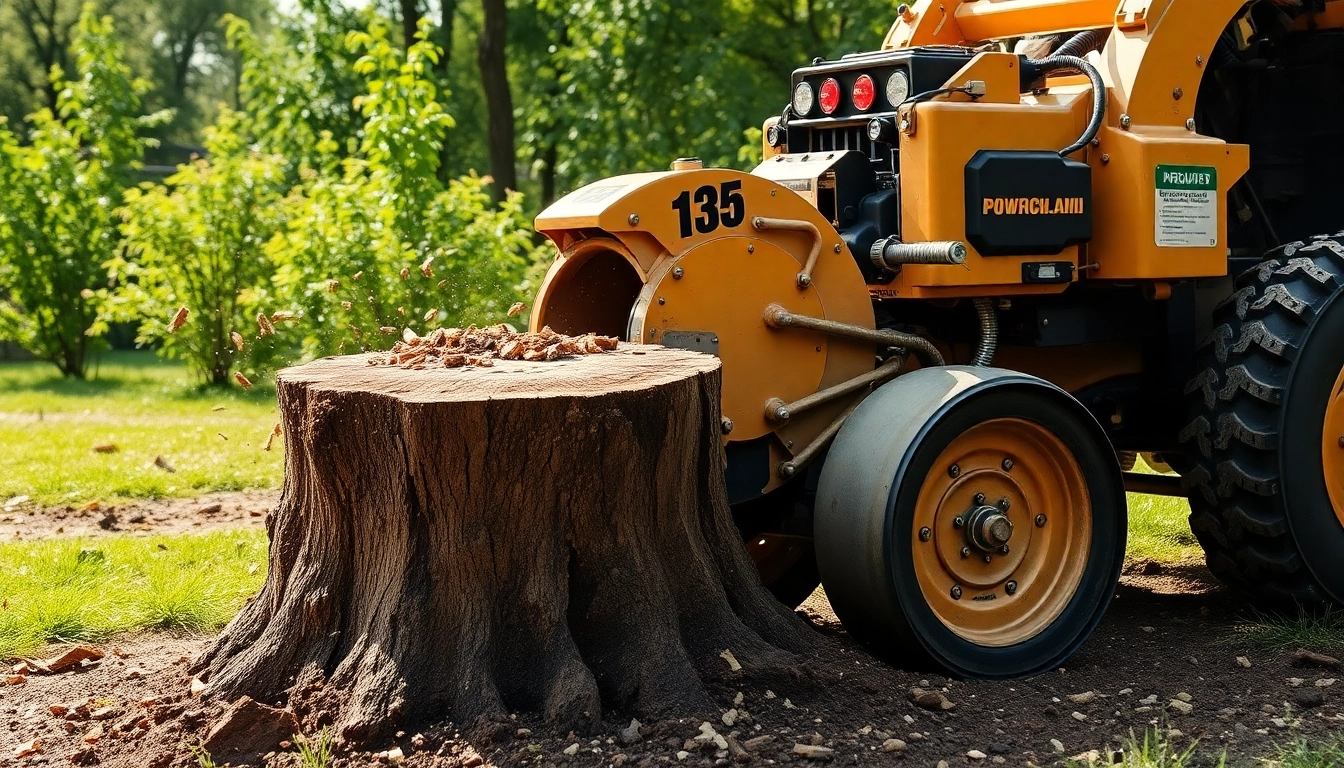
How to Choose the Best Stump Grinder for Your Landscaping Needs
Understanding the Basics of Stump Grinders
What is a Stump Grinder?
A stump grinder is a specialized piece of equipment designed to remove tree stumps and the roots that lie beneath the surface. This machine works by utilizing a rotating blade that grinds the stump into small chips, allowing for a clean and efficient removal process. The use of a stump grinder ensures that the area can be easily reseeded or replanted after the stump is removed, contributing to the overall aesthetics of a landscape. For anyone looking to remove a stump effectively, investing in a stump grinder can be a worthwhile consideration.
How Stump Grinders Work
Stump grinders operate by rotating a heavy metal wheel with sharp teeth. This wheel cuts through the stump and grinds it down, turning it into small wood chips. The process typically involves several steps:
- Positioning: The stump grinder is positioned over the stump, ensuring that the grinding wheel is aligned correctly to maximize effectiveness.
- Grinding: The operator activates the grinder, and the wheel begins to spin rapidly. As it makes contact with the stump, it grinds away the wood, working downwards and sideways to effectively remove the stump.
- Removal of Debris: The resulting wood chips can either be left on-site for soil enrichment or removed for a cleaner finish.
This process can vary significantly depending on the size and condition of the stump, the type of stump grinder used, and the experience of the operator.
Types of Stump Grinders: A Comprehensive Guide
Stump grinders come in various types, each designed for specific applications and users. Understanding the different types can help you choose the right one for your needs:
- Walk-behind Stump Grinders: These are small, portable machines perfect for homeowners or small landscaping jobs. They are easy to maneuver and ideal for residential projects.
- Self-propelled Stump Grinders: Offering higher performance than walk-behind models, self-propelled grinders are equipped with tracks or wheels that allow them to easily navigate over uneven terrain.
- Tow-behind Stump Grinders: Designed for towing behind trucks or tractors, these models are best suited for larger job sites where mobility is key. They can handle bigger stumps efficiently.
- Commercial Stump Grinders: Built for professional landscapers and arborists, these rugged machines offer powerful engines and advanced features for high-volume stump removal.
Factors to Consider When Buying a Stump Grinder
Power and Performance
The power of a stump grinder is typically measured in horsepower, and it directly affects how efficiently the machine can operate. Higher horsepower models can tackle larger and harder stumps more quickly, making them a better choice for professional use or large properties. Consider the following points:
- Engine Type: Gas-powered engines generally provide more power than electric models, making them suitable for larger jobs.
- Cutting Width: Wider cutting blades can grind stumps faster but may require more space to operate.
- Safety Features: Models with features such as automatic shut-off systems and protective guards enhance safety during operation.
Size and Portability
Depending on your needs, size and portability are critical factors. If you’re solely working in residential areas, a smaller, walk-behind model may suffice. However, if you anticipate needing a stump grinder for commercial projects, consider a tow-behind or self-propelled model for better maneuverability and efficiency. Think about the following:
- Weight: Heavier machines may be more powerful but can be more challenging to transport.
- Dimensions: Ensure the size of the machine fits your intended use area, whether it’s tight corners of a residential yard or open landscapes.
Cost vs. Value Analysis
The price of stump grinders can range from a few hundred to several thousand dollars. When evaluating cost, it’s essential to balance upfront investment with long-term value. Take into account:
- Durability: Higher initial costs often correlate with better build quality and longer lifespan.
- Maintenance Costs: Factor in ongoing expenses for maintenance, replacement parts, and fuel when considering your budget.
- Resale Value: Popular and high-quality brands often retain better resale value, making them a wise investment if you plan to upgrade in the future.
Benefits of Using a Stump Grinder
Efficiency in Stump Removal
Stump grinders excel in speed and efficiency, often removing a stump in just a couple of hours, compared to days of manual labor. They can grind stumps of varying sizes down to ground level, allowing for quick recovery of the area. This not only saves time but also minimizes disruption to your landscape.
Safety Compared to Manual Methods
Trying to remove a stump manually can pose considerable risks. Using a stump grinder enhances safety by mitigating the physical strain and potential injuries associated with manual digging and chopping. Operators can remain at a safe distance from the grinding wheel, and many modern stump grinders are designed with safety features that protect against accidents.
Environmental Considerations
Grinding stumps can be beneficial for the environment. The wood chips created from grinding can be reused as mulch or compost, providing nutrients back to the soil. Additionally, stump grinding removes a potential habitat for pests and diseases, promoting a healthier landscape overall.
Maintenance Tips for Your Stump Grinder
Regular Inspections
Routine maintenance is crucial to extending the lifespan of your stump grinder. Regular inspections can identify wear and tear before they lead to significant mechanical failures. Consider the following:
- Check Fluid Levels: Ensure oil, coolant, and fuel levels are adequate to ensure smooth operation.
- Inspect Belts and Cables: Look for signs of wear on belts and cables, and replace them as necessary.
Sharpening and Replacing Cutting Teeth
Keeping the cutting teeth sharp is essential for efficient stump grinding. Dull teeth can lead to longer grind times and increased wear on the machine. Find a routine for sharpening or replacing the teeth based on usage; many professionals recommend doing this after every 10-15 hours of operation.
Storage and Transportation Best Practices
Proper storage and transportation practices will help you maintain the functionality of your stump grinder. Store the machine in a dry place and protect it from extreme weather conditions. If transporting the grinder, ensure it is securely fastened to avoid movement during transport, which could cause mechanical damage.
Frequently Asked Questions About Stump Grinders
What is the average cost of stump grinding?
The average cost for stump grinding typically falls between $140 and $450. However, this can vary significantly depending on several factors, including the size of the stump, its age, and any additional challenges encountered during the grinding process.
How long does it take to grind a stump?
Grinding a stump typically takes around two hours for average-sized stumps. However, particularly large stumps can take four to six hours to fully grind down, depending on factors such as wood density and age.
Is it better to rent or buy a stump grinder?
The decision to rent or buy a stump grinder hinges on how often you plan to use it. For infrequent users, renting makes sense due to reduced upfront costs. Conversely, if you regularly perform stump removals, purchasing a grinder offers greater long-term value and convenience.
